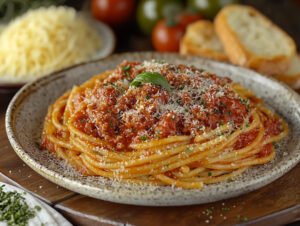The Origins of Spaghetti Bolognese
Spaghetti Bolognese is one of the most beloved and widely recognized dishes around the world, but its true origins and the authentic recipe often surprise those unfamiliar with Italian cuisine. While many people associate the dish with a rich, meaty tomato sauce served over spaghetti, the traditional roots of Bolognese take us far beyond this modern interpretation. To understand its origins, we need to journey to Bologna, Italy—home of the true Ragù alla Bolognese.
A Dish Born in Bologna
Bologna, a historic city in northern Italy, is famous for its culinary traditions, and Ragù alla Bolognese is one of its most iconic contributions. The name “Bolognese” itself is derived from “Bologna,” linking the sauce directly to its hometown. This rich meat-based sauce is deeply intertwined with the local culture, reflecting centuries of food heritage.
Interestingly, the original version of Bolognese sauce was not paired with spaghetti at all! In Bologna, Tagliatelle (a wide, flat egg pasta) is the traditional pasta choice for serving Ragù alla Bolognese. The rougher texture of tagliatelle allows the thick sauce to cling better to the pasta.
The Authentic Bolognese Recipe
The original recipe for Ragù alla Bolognese dates back to 1891 when it first appeared in a cookbook by Pellegrino Artusi, a famous Italian gastronome. The traditional recipe is quite different from what most people think of today. Instead of relying heavily on tomatoes, the Bolognese sauce is primarily made from finely chopped or ground meats, such as beef and pork, slowly simmered with onions, carrots, celery, and a small amount of tomato paste. White wine and milk or cream are also essential ingredients that give the sauce its rich, velvety texture.
This slow-cooking process, which can take several hours, allows the flavours to meld together, creating a robust and deeply satisfying sauce. Unlike many modern versions of the dish, Ragù alla Bolognese is less about being tomato-heavy and more focused on the balance between meat, wine, and vegetables.
Spaghetti Bolognese: A Global Twist
While the traditional Ragù alla Bolognese is served with tagliatelle or other thick pasta shapes like pappardelle, the dish took on a new form as Italian immigrants began to spread their culinary culture abroad. It was during this time that spaghetti, a long and thin pasta from southern Italy, became the pasta of choice to pair with the Bolognese-style sauce.
This pairing became especially popular in countries like the United States and the United Kingdom, where “Spaghetti Bolognese” emerged as a fusion dish. While it bears little resemblance to the original Bolognese from Bologna, it has nonetheless become a comfort food staple around the world.
Bolognese Sauce and Italian Tradition
For Italians, Bolognese is more than just a meal—it’s a representation of tradition, time, and care. The dish speaks to Italy’s slow food philosophy, which emphasizes the importance of preparing food with patience and high-quality ingredients. In Italy, Ragù alla Bolognese is often a centrepiece at family gatherings, with each household sometimes having its own slight variation on the classic recipe, passed down from generation to generation.
The Bolognese Evolution
Today, the Accademia Italiana della Cucina (The Italian Academy of Cuisine) safeguards the traditional recipe of Ragù alla Bolognese, and in 1982, they submitted the official recipe to the Bologna Chamber of Commerce. However, this doesn’t mean there isn’t room for creativity in the kitchen. Many chefs worldwide have experimented with Ragù alla Bolognese, incorporating regional ingredients and personal twists, all while respecting the dish’s origins.
Though it has taken on many different forms and interpretations worldwide, the heart of Spaghetti Bolognese lies in the classic Ragù alla Bolognese of Bologna. The dish’s journey from Italy to the global stage highlights the versatility and enduring appeal of Italian cuisine. Whether you enjoy it with tagliatelle in Bologna or spaghetti at home, it remains a comforting, hearty meal steeped in history.
Next time you dig into a plate of Bolognese, remember that you’re tasting a piece of Italian tradition, perfected over generations and embraced by food lovers everywhere.


 22 Chapel Ash, Wolverhampton, WV3 0TN
22 Chapel Ash, Wolverhampton, WV3 0TN




